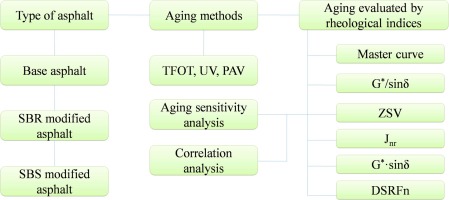Our official English website, www.x-mol.net, welcomes your
feedback! (Note: you will need to create a separate account there.)
Evaluation of aging behaviors of asphalt binders through different rheological indices
Fuel ( IF 6.7 ) Pub Date : 2018-06-01 , DOI: 10.1016/j.fuel.2018.02.087 Henglong Zhang , Zihao Chen , Guoqing Xu , Caijun Shi
Fuel ( IF 6.7 ) Pub Date : 2018-06-01 , DOI: 10.1016/j.fuel.2018.02.087 Henglong Zhang , Zihao Chen , Guoqing Xu , Caijun Shi

|
Abstract The performance of asphalt pavement is seriously affected by aging of asphalt binder, so indices are expected which can not only evaluate aging resistance of asphalt binder but also indicate asphalt mixture performance. The objective of this paper was just to investigate effects of different rheological indices which present tighter and clearer correlation with asphalt mixture performance in evaluating asphalt binder aging behaviors, these indices including complex modulus (G ∗ ) and phase angle (δ) master curves, rutting factor (G ∗ /sinδ), zero shear viscosity (ZSV), non-recoverable compliance (J nr ), fatigue factor (G ∗ ·sinδ) and DSR function (DSRFn). Thin film oven test (TFOT), pressure aging vessel (PAV) test and ultraviolet (UV) irradiation were applied to simulate short-term, long-term thermal oxidation and photo oxidation aging, respectively. Frequency sweep tests and multiple stress creep recovery (MSCR) tests were conducted on three asphalt binders (60/80 pen grade base asphalt, styrene–butadiene-styrenecopolymer (SBS) modified asphalt and styrene butadiene rubber (SBR) modified asphalt) at different aging conditions. Meanwhile, aging sensitivities shown by different rheological indices were compared. The relationships between rheological indices were also discussed. The results showed that the ranking of aging resistances among asphalt binders evaluated by different rheological indices were nearly consistent and SBS modified asphalt exhibited the best aging resistance to three aging methods. J nr and δ tended to decrease with the growth of aging severity, whereas other rheological indices were just contrary to this trend. Moreover, DSRFn proved to be the most sensitive index to aging. Based on correlation analyses, three groups of indices exhibited a strong correlation to each other, namely DSRFn versus G ∗ /sinδ, J nr (0.1 kPa) versus J nr (3.2 kPa) and J nr (0.1 kPa) versus ZSV.
中文翻译:

通过不同流变指标评价沥青结合料老化行为
摘要 沥青路面的性能受沥青结合料老化的影响很大,因此期望有指标既可以评价沥青结合料的抗老化性能,又可以反映沥青混合料的性能。本文的目的只是研究与沥青混合料性能更紧密、更清晰的相关性的不同流变指标在评价沥青结合料老化行为时的影响,这些指标包括复数模量 (G ∗ ) 和相角 (δ) 主曲线、车辙因子 (G ∗ /sinδ)、零剪切粘度 (ZSV)、不可恢复顺应性 (J nr )、疲劳因子 (G ∗ ·sinδ) 和 DSR 函数 (DSRFn)。应用薄膜烘箱试验(TFOT)、压力老化容器(PAV)试验和紫外线(UV)照射来模拟短期、长期热氧化和光氧化老化,分别。在不同老化条件下对三种沥青结合料(60/80 笔级基础沥青、苯乙烯-丁二烯-苯乙烯共聚物(SBS)改性沥青和丁苯橡胶(SBR)改性沥青)进行了频率扫描测试和多应力蠕变恢复(MSCR)测试使适应。同时,比较了不同流变指标显示的老化敏感性。还讨论了流变指标之间的关系。结果表明,不同流变学指标评价的沥青结合料的耐老化性排序基本一致,SBS改性沥青对三种老化方法的耐老化性最好。J nr 和 δ 有随着老化程度的增加而降低的趋势,而其他流变学指标正好相反。而且,DSRFn 被证明是对衰老最敏感的指标。根据相关性分析,三组指数之间表现出很强的相关性,即 DSRFn 与 G ∗ /sinδ、J nr (0.1 kPa) 与 J nr (3.2 kPa) 和 J nr (0.1 kPa) 与 ZSV。
更新日期:2018-06-01
中文翻译:

通过不同流变指标评价沥青结合料老化行为
摘要 沥青路面的性能受沥青结合料老化的影响很大,因此期望有指标既可以评价沥青结合料的抗老化性能,又可以反映沥青混合料的性能。本文的目的只是研究与沥青混合料性能更紧密、更清晰的相关性的不同流变指标在评价沥青结合料老化行为时的影响,这些指标包括复数模量 (G ∗ ) 和相角 (δ) 主曲线、车辙因子 (G ∗ /sinδ)、零剪切粘度 (ZSV)、不可恢复顺应性 (J nr )、疲劳因子 (G ∗ ·sinδ) 和 DSR 函数 (DSRFn)。应用薄膜烘箱试验(TFOT)、压力老化容器(PAV)试验和紫外线(UV)照射来模拟短期、长期热氧化和光氧化老化,分别。在不同老化条件下对三种沥青结合料(60/80 笔级基础沥青、苯乙烯-丁二烯-苯乙烯共聚物(SBS)改性沥青和丁苯橡胶(SBR)改性沥青)进行了频率扫描测试和多应力蠕变恢复(MSCR)测试使适应。同时,比较了不同流变指标显示的老化敏感性。还讨论了流变指标之间的关系。结果表明,不同流变学指标评价的沥青结合料的耐老化性排序基本一致,SBS改性沥青对三种老化方法的耐老化性最好。J nr 和 δ 有随着老化程度的增加而降低的趋势,而其他流变学指标正好相反。而且,DSRFn 被证明是对衰老最敏感的指标。根据相关性分析,三组指数之间表现出很强的相关性,即 DSRFn 与 G ∗ /sinδ、J nr (0.1 kPa) 与 J nr (3.2 kPa) 和 J nr (0.1 kPa) 与 ZSV。











































 京公网安备 11010802027423号
京公网安备 11010802027423号